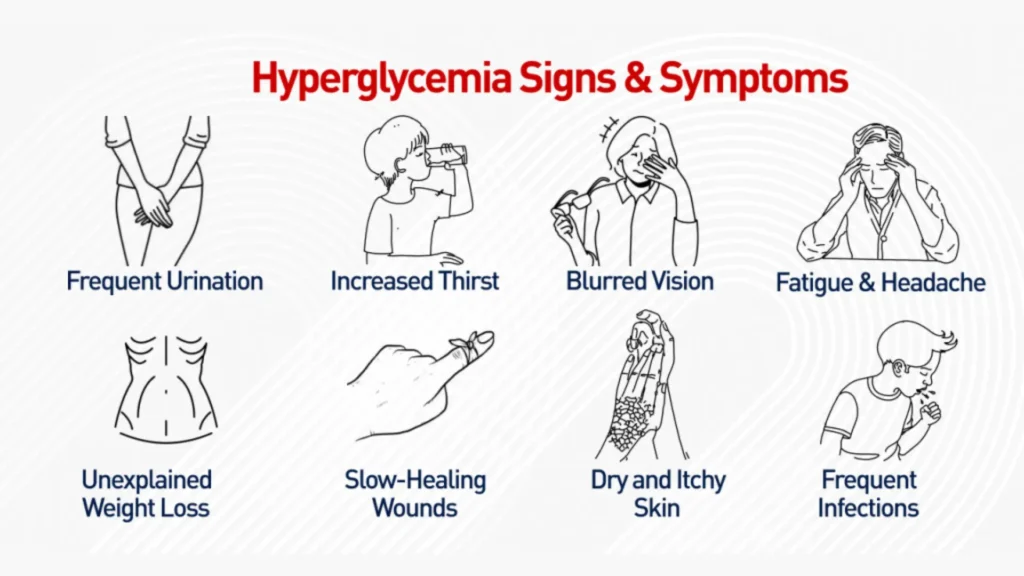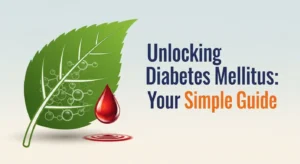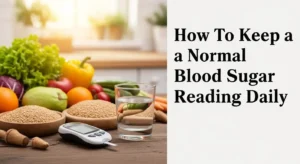Do you know what signs are high blood sugar symptoms? Spotting these signs early can greatly improve your health.

High blood sugar, or hyperglycemia, shows in different ways. You might feel very thirsty and need to pee a lot. You could also feel tired or see things less clearly. Knowing these signs is key to acting fast.
Spotting high blood sugar symptoms early can stop big problems. Pay attention to how your body feels. If something seems off, talk to a doctor right away.
The Silent Danger of Elevated Blood Glucose
Elevated blood glucose levels can be a big health risk. They often don't show symptoms. If not managed, they can lead to serious health problems.
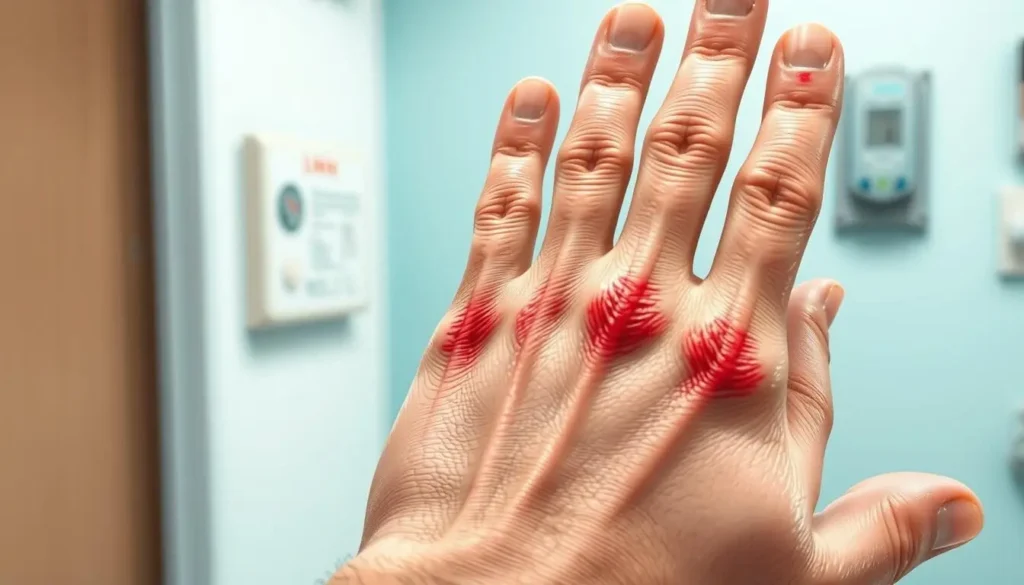
What Happens in Your Body When Sugar Levels Rise
When your blood sugar goes up, your body can't control glucose well. This can cause insulin resistance, a sign of type 2 diabetes.
How Insulin Resistance Develops
Insulin resistance happens when your cells don't respond to insulin well. This makes it hard for glucose to get into cells. Your pancreas then makes more insulin, starting a cycle.
The Difference Between Prediabetes and Diabetes
Prediabetes means your blood sugar is higher than normal but not diabetes level. If not treated, it can turn into type 2 diabetes.
The Progression from Normal to Dangerous Levels
The move from normal to dangerous blood sugar levels is slow. Genetics, obesity, and not being active can speed it up.
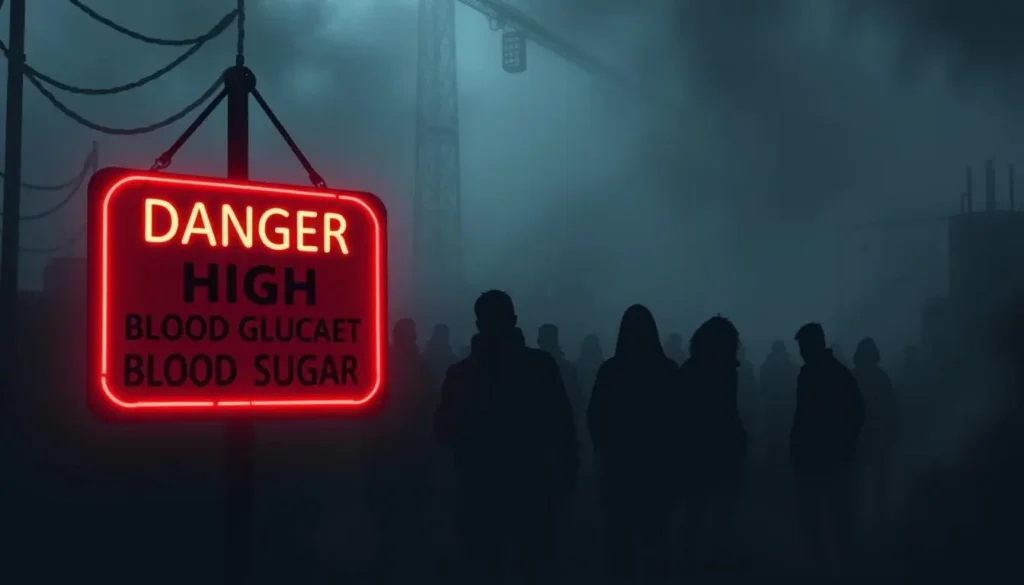
Knowing the signs of high blood glucose and the difference between prediabetes and diabetes is key. It helps catch problems early.
High Blood Sugar Symptoms: The Classic Warning Signs
High blood sugar can cause many noticeable symptoms. These signs should not be ignored. If left unchecked, they can lead to severe health issues.
Excessive Thirst and Frequent Urination
One common symptom is feeling very thirsty and needing to urinate a lot. This happens because the kidneys try to get rid of extra glucose by making more urine.
Why Hyperglycemia Makes You Thirsty
As you lose water through urination, you get dehydrated. This makes you feel thirsty. The more you urinate, the thirstier you get.
When Normal Thirst Becomes a Concern
It's normal to feel thirsty sometimes. But if you're always thirsty and can't seem to quench it, it might be a sign of a problem with your blood sugar.
Unexplained Weight Loss Despite Normal Eating
Another symptom is losing weight without trying. When your cells can't use glucose for energy, they start breaking down fat and muscle. This leads to weight loss.
Persistent Fatigue and Weakness
High blood sugar symptoms can also make you feel very tired and weak. When your cells can't use glucose well, you don't have enough energy. This makes you feel tired and sluggish.
| Symptom | Description | Possible Complications if Untreated |
|---|---|---|
| Excessive Thirst and Urination | Increased glucose in blood leads to more urine production, causing dehydration. | Dehydration, kidney strain |
| Unexplained Weight Loss | Body breaks down fat and muscle for energy due to cells not receiving glucose. | Malnutrition, loss of muscle mass |
| Fatigue and Weakness | Inefficient glucose uptake by cells results in lack of energy. | Reduced productivity, increased risk of accidents |
Subtle Indicators Your Glucose Levels Are Too High
Many people know the classic signs of high blood sugar. But there are subtle signs that often go unnoticed. These signs are just as important for spotting glucose level issues.
Blurred Vision and Eye Problems
Blurred vision is a subtle sign of high blood sugar. High glucose levels can swell the lens in your eye. This makes it hard to focus and can lead to serious eye problems if not treated.
Slow-Healing Cuts and Wounds
Slow healing of cuts and wounds is another sign of high blood sugar. High blood sugar symptoms damages blood vessels and nerves. This slows down the healing process, making injuries harder to recover from.
Recurring Infections and Skin Issues
Frequent infections and skin problems can also point to high blood sugar. High glucose levels weaken the body's fight against infections.
Yeast Infections and Their Connection to Blood Sugar
Yeast infections are common in people with high blood sugar symptoms. It grows well in high glucose environments, making infections more likely.
Skin Tags and Acanthosis Nigricans
Skin tags and acanthosis nigricans, dark, velvety skin patches, are linked to high blood sugar symptoms. These skin issues often appear in the neck, armpits, or groin.
When High Blood Sugar Becomes a Medical Emergency
High blood sugar can cause serious problems. It's important to know the signs to get help fast.
Warning Signs of Diabetic Ketoacidosis
Diabetic ketoacidosis (DKA) is a serious issue. It happens when the body makes too many ketones. These are acidic substances that can harm the body. Look out for these symptoms:
- High blood sugar levels
- Fruity-smelling breath
- Nausea and vomiting
- Abdominal pain
- Confusion or difficulty concentrating
Hyperosmolar Hyperglycemic State Symptoms
Hyperosmolar hyperglycemic state (HHS) is a severe problem. It's more common in type 2 diabetes. It's caused by very high blood sugar and dehydration. Watch for these signs:
- Very high blood sugar levels
- Dehydration and dry mouth
- Confusion or altered mental state
- Seizures or coma in severe cases
When to Call 911 vs. When to Call Your Doctor
Knowing when to get emergency help is key. Call 911 if you or someone else has:
- Severe symptoms of DKA or HHS
- Loss of consciousness
- Severe chest pain or difficulty breathing
If symptoms are not severe, call your doctor. They can tell you what to do next.
| Condition | Symptoms | Action |
|---|---|---|
| Diabetic Ketoacidosis (DKA) | High blood sugar, fruity-smelling breath, nausea, abdominal pain | Seek emergency care if severe |
| Hyperosmolar Hyperglycemic State (HHS) | Very high blood sugar, dehydration, confusion | Seek emergency care if severe |
My Journey with Hyperglycemia: Recognizing the Signs
Looking back, the early signs of hyperglycemia were hidden by daily stress. It wasn't until I noticed a mix of symptoms that I suspected something was wrong.
The Symptoms I Initially Dismissed as Stress
I first noticed I was thirsty and tired, blaming it on work and lack of sleep. But these signs didn't go away. I felt a constant feeling of being unwell.
How My Daily Life Was Affected Before Diagnosis
My daily tasks became hard as symptoms got worse. Even simple things felt like huge challenges because of fatigue and weakness. Blurred vision also made reading and computer work hard.
| Symptom | Impact on Daily Life |
|---|---|
| Excessive Thirst | Frequent need to drink water, disrupting work and daily activities |
| Fatigue | Difficulty completing tasks, feeling weak |
| Blurred Vision | Challenges with reading, computer work, and driving |
What Finaly Convinced Me to Get Tested
A bad episode of dizziness and confusion made me go to the doctor. It was a clear sign that something was seriously wrong.
The Wake-Up Call That Changed Everything
Learning I had hyperglycemia was a big change. It showed me how important it is to control my blood sugar and make big lifestyle changes.
Effective Strategies to Control Elevated Blood Sugar
Managing high blood sugar levels needs a mix of diet changes, regular exercise, and stress management.
Dietary Changes That Made the Biggest Difference
Changing your diet is key to controlling blood sugar. It's important to know how different foods affect your glucose levels.
Carbohydrate Counting and Glycemic Index
Counting carbs helps manage carb intake, which affects blood sugar. The glycemic index guides food choices by showing how quickly a food raises blood glucose.
- Choose whole, unprocessed foods like veggies, fruits, and whole grains.
- Avoid foods with added sugars and refined carbs.
The Surprising Foods That Spiked My Levels
Some foods, even healthy ones, can raise blood sugar levels. Certain fruits and starchy veggies can have a high glycemic impact.
| Food | Glycemic Index | Impact on Blood Sugar |
|---|---|---|
| White Bread | 70-80 | High |
| Brown Rice | 50 | Moderate |
| Apple | 38 | Low |
Exercise Routines That Help Regulate Glucose
Regular exercise is essential for managing blood sugar. It helps your body use insulin better.
- Try aerobic exercises like walking, cycling, or swimming.
- Do resistance training to build muscle.
Stress Management and Sleep: The Overlooked Factors
Stress and poor sleep can greatly affect blood sugar levels. It's important to manage stress and get enough sleep.
- Use stress-reducing activities like meditation or yoga.
- Try to sleep 7-8 hours each night.
Conclusion: Taking Control of Your Blood Sugar Health
Knowing the high blood sugar symptoms are key to managing your health. By spotting these signs early, you can make better choices. This helps you control your diabetes and avoid serious problems.
Controlling blood sugar involves more than just diet. It also means regular exercise and managing stress. These habits can greatly improve your health and happiness.
Managing your blood sugar is a long-term effort. It needs your full commitment and dedication. By staying informed and proactive, you can overcome diabetes challenges. And you can live a healthy, active life.


